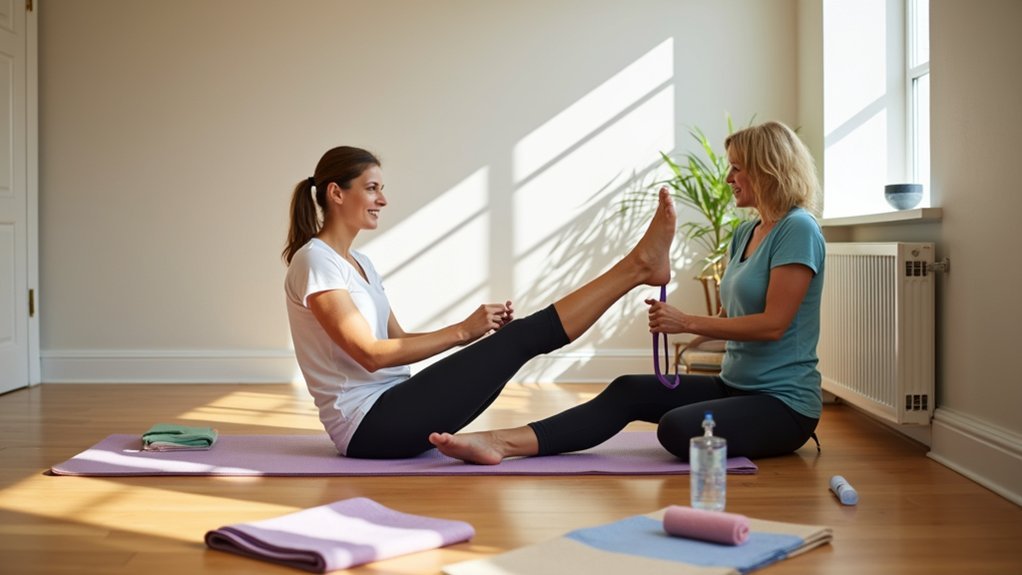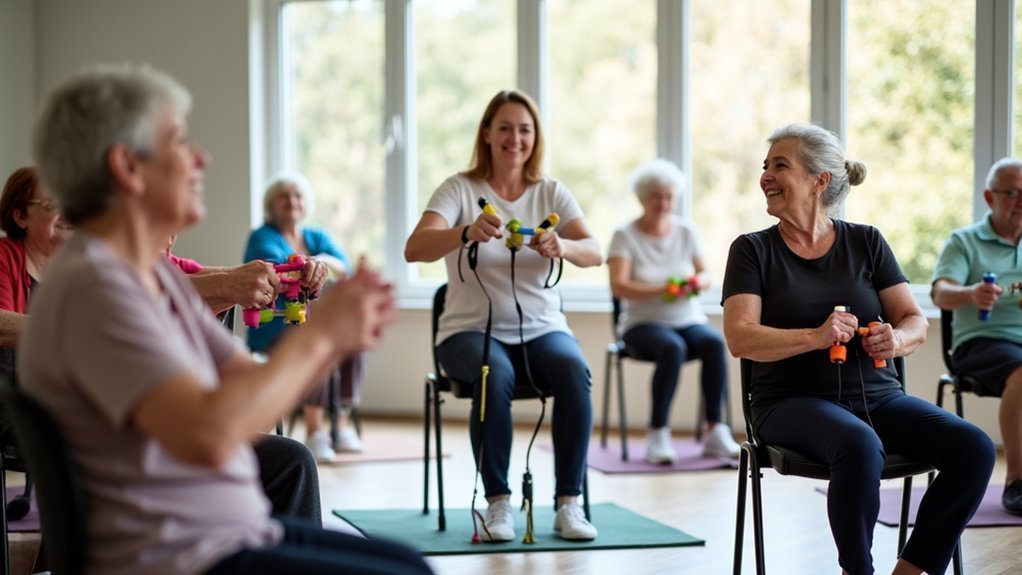After joint replacement surgery, you can safely rebuild strength with gentle walking sessions starting at 5-10 minutes and gradually increasing as tolerated. Try stationary cycling on low resistance to improve mobility without stressing your new joint. Water exercises like aqua jogging or gentle swimming provide excellent low-impact options while supporting your body weight. Always get clearance from your surgeon before starting these activities. The right approach will help you regain function while protecting your investment.
Gentle Rebounding Techniques for New Joint Recipients

While recovering from joint replacement surgery, rebounding exercises on a mini-trampoline can offer valuable low-impact movement that strengthens muscles around your new joint.
Always obtain physician clearance before starting.
Begin with the Basic Bounce—gentle, low-impact movements that build balance and confidence.
Try Step Taps by tapping one heel at a time while maintaining stability.
Weight Shift Jumps involve gently transferring your weight from foot to foot with slight bouncing.
Heel Raises provide gentle mobility without excessive impact.
Start with 5-10 minute sessions and always wear shock-absorbing footwear.
Use handlebars for stability and stop immediately if you experience pain.
Position your rebounder in the room’s center on a non-slip surface, and verify weight is evenly distributed to protect your new joint.
Maintain a slight bend in knees throughout all rebounding exercises to reduce pressure on your new joint and ensure proper form.
Low-Impact Trampoline Exercises to Rebuild Strength
After receiving clearance from your physician, low-impact trampoline exercises offer an excellent way to rebuild strength around your new joint without excessive stress.
Rebounding exerts just 1/6 the force on joints compared to pavement walking, making it ideal for recovery.
Walking on a trampoline reduces joint impact to just 1/6 that of sidewalk walking—a gentle path to rebuilding strength.
Start with health bounces, keeping your feet in contact with the surface. As you progress, try gentle marching in place or slow side-to-side steps. Always wear supportive shoes and use handlebars initially for stability.
Begin with 5-10 minute sessions and gradually increase duration based on your comfort level. The trampoline’s forgiving surface allows you to improve balance, boost circulation, and strengthen muscles surrounding your new joint—all critical components for successful rehabilitation. Rebounding also stimulates lymphatic system for better removal of toxins and waste products that can accumulate during recovery.
If you experience any discomfort, immediately stop and consult your healthcare provider.
Progressive Mini-Trampoline Routines for Joint Mobility

Progressive mini-trampoline routines release more advanced mobility benefits for your replaced joint with minimal stress.
Begin with gentle heel bobs and side-to-side hip shakes to activate joints gradually without strain. Add slow hip twists with knees gently poked outward to mobilize your entire lower body chain.
As you progress, introduce controlled jumping jacks and arm reaches while bouncing to engage multiple joints simultaneously. If bouncing feels uncomfortable, keep your feet stationary with small controlled movements.
For targeted benefits, focus on hip rotation exercises for hip replacements or ankle activation holds for knee replacements. The pliable jumping surface helps reduce stress on your new joint while providing sufficient resistance for effective rehabilitation. Use the trampoline rim for support during challenging movements.
These routines strengthen muscles around your new joint while improving coordination, balance, and overall joint function.
Frequently Asked Questions
When Can I Safely Resume Sexual Activity After Joint Replacement?
You can usually resume sexual activity 4-6 weeks after joint replacement if your incisions have healed and pain is manageable. Start gradually, avoid extreme positions, and stop if you experience pain. Consult your surgeon for personalized guidance.
How Do I Navigate Stairs Safely During Early Recovery?
During early recovery, you’ll navigate stairs safely by ascending with your good leg first and descending with your operated leg first. Use handrails, take one step at a time, and don’t rush. Consider using assistive devices.
Can I Drive After Joint Replacement Surgery?
You can’t drive immediately after joint replacement surgery. For right knee surgery, wait at least 4 weeks; left knee may be 2 weeks with automatic transmission. Never drive while taking narcotic pain medication.
Is Yoga Appropriate After Joint Replacement Surgery?
Yes, you can practice yoga after joint replacement surgery, but you’ll need your surgeon’s clearance first. Start with gentle modifications, avoid extreme joint movements, and progress gradually as your healing allows.
How Long Should I Use Assistive Devices After Surgery?
You’ll typically use a walker for 2-4 weeks after joint replacement surgery, then shift to crutches and eventually a cane. Your doctor will determine your exact timeline based on your recovery progress.
In Summary
You’ve now discovered three rebounding exercises that can safely support your recovery after joint replacement. By starting with gentle bouncing, progressing to low-impact movements, and eventually incorporating more dynamic routines, you’ll rebuild strength and mobility at your own pace. Always listen to your body and consult your physical therapist before trying these mini-trampoline exercises. Your new joint deserves proper care during this important healing journey.





Leave a Reply